The ASTM A500 steel pipes have been a common element in the construction industry because they are durable, strong, and relatively cheap. These pipes are available in four grades, which are A, B, C, and D, with various mechanical properties to meet various structural requirements. They can be utilized in construction under a very broad range of applications, such as simple building frames and sensitive infrastructure development.
Commercial and Residential Buildings Framing
The structural framework of buildings is one of the most common applications of the ASTM A500 steel pipes. Grade B and Grade C are commonly used in building commercial and residential buildings because they offer a perfect combination of strength and cost. They are applied in columns, beams, and joists to give the required support to buildings with multiple stories and large spaces. They have uniform thickness of walls and can adequately carry loads on the floor, roof, and other constructions. A500 steel pipes have high torsion and bending resistance, which guarantees structural stability as time goes by, even with variable loads.
Bridge and Transportation Structure Support
The ASTM A500 steel pipes, especially Grades C and D, are important in the construction of bridges. They are high tensile strength and yield strength, hence can withstand the dynamic and static forces applied to the bridges. The pipes are applied in the trusses of bridges, support columns, and cross-bracing members where strength and flexibility are of the utmost essence. They also have the advantage of being corrosion resistant when coated or galvanized properly, and this makes them last longer, in particular in environments that are subject to moisture or deicing chemicals. The inclusion of A500 pipes in critical parts can help engineers in pedestrian and vehicular bridges to ensure durability and safety.
Construction of Industrial Buildings
The ASTM A500 steel pipes are also widely used in industrial buildings of facilities like factories, warehouses, and plants. Such environments require materials capable of handling heavy machinery and high operational stress. Grade C and D are the best suited in this because they perform better under high loads. A500 pipes also have consistent dimensional tolerances, which makes it really easy to integrate them with other structural elements, thus decreasing the time and the costs of installation. These pipes also support the physical structure of the facility, but are commonly found in mezzanines, walkways, and equipment platforms, and they are very durable and supportive.
Infrastructure and Utility Projects
The ASTM A500 steel pipes have been used in major infrastructure like retaining structures, fencing, light poles, and utility supports. They are highly adaptable and durable, thereby making them the most preferred in the supply of utility lines, traffic signs, and street lights. Pipes with Grade D that are the strongest in the A500 category are popularly selected in installations that are required to withstand high wind loads or seismic action. They can also be configured to fit the specific needs of various infrastructure designs due to their ease of fabrication, and this makes them unavoidable in contemporary civil engineering.
Temporary and Modular Structures
The application of ASTM A500 steel pipes in temporary and modular buildings is becoming popular because of their lightweight and ease of completion. Grade A pipes, although their strength is the least of all four grades, are perfect to use in temporary installations, including scaffolding, temporary shelters, and event structures. These pipes are sufficiently supported to be used in the short term, and they are not excessively reinforced or durable. They are compatible with normal fittings and connectors, making the building process easier and faster to disassemble and move, which is essential in temporary construction.
Architectural and Aesthetic Uses
In addition to their structural value, ASTM A500 steel pipes are also being sought because of their clean lines and contemporary look in the architecture field. Exposed portions of pipe are frequently used in designs by designers in buildings, bridges, and even in open spaces. It is both to serve a purpose and to provide ornamentation. The look of the A500 tubing is consistent and smooth, making it suitable for architectural detailing, including handrails, stairways, and facade components. These pipes can be painted or powder-coated to give a beautiful picture to a structure, at the same time serving important structural capacities.
Conclusion
In the construction business, the ASTM A500 steel pipes are the most flexible and effective to use. Such pipes come in various strengths, durability, and reliability. These are used in residential structures, industrial plants, bridges, and infrastructure projects. With the ever-changing construction requirements, ASTM A500 steel pipes have never been a more reliable construction material to construct future and present structures.
